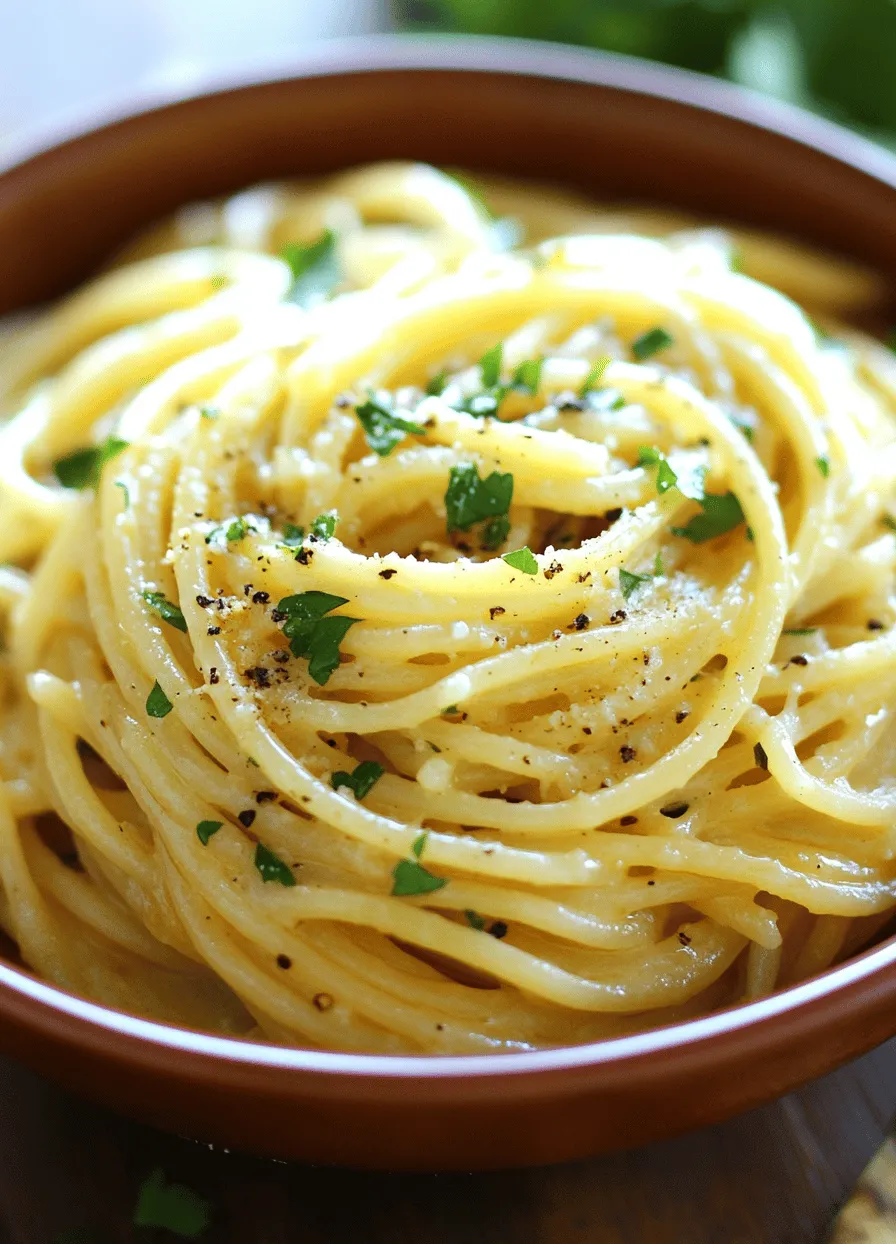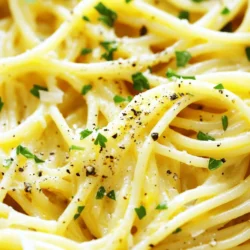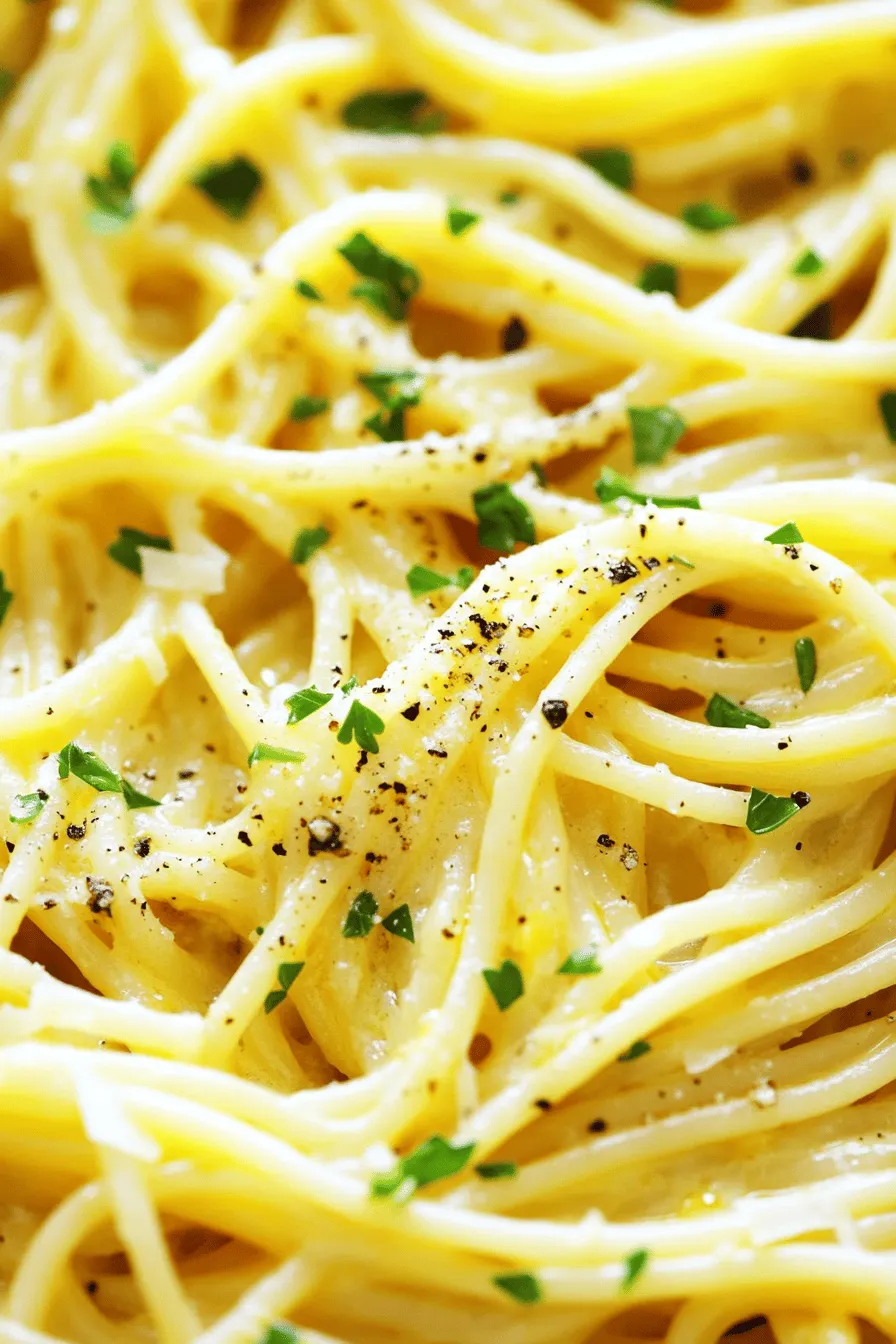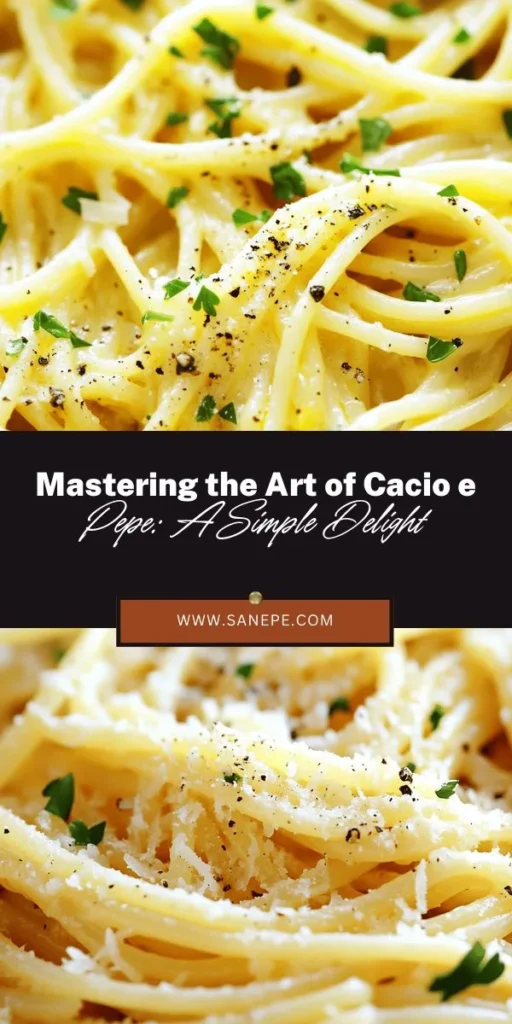Cacio e Pepe, a traditional Roman dish, is a celebration of simplicity, flavor, and quality ingredients. This delightful pasta dish, made primarily from just three ingredients—Pecorino Romano cheese, freshly cracked black pepper, and pasta—embodies the essence of Italian culinary philosophy. The name “Cacio e Pepe” translates to “cheese and pepper,” highlighting the two cornerstone ingredients that elevate this dish to a level of culinary artistry. In this article, we will explore not only the recipe for Cacio e Pepe Delight but also its history, variations, and the techniques that make it a favorite among pasta lovers. Whether you’re a novice cook or a seasoned chef, this guide will ensure that you master the art of creating a creamy and flavorful Cacio e Pepe.
Understanding Cacio e Pepe
Historical Background
The origins of Cacio e Pepe can be traced back to the rural regions of Rome, where shepherds would prepare this dish using the most accessible ingredients. The simplicity of Cacio e Pepe reflects the resourcefulness of these early cooks, who relied on readily available staples to create a flavorful meal. Traditionally, the dish was made with ingredients that were easy to transport and store, making it a popular choice for those on the move.
Over time, Cacio e Pepe gained popularity not just among the working class but also in the higher echelons of Roman society. Its significance in Italian culture is profound, illustrating the Italian culinary philosophy that emphasizes quality over quantity. Today, Cacio e Pepe is celebrated in restaurants across Italy and the world, often regarded as a must-try dish for anyone exploring Roman cuisine.
Key Ingredients and Their Importance
Cacio e Pepe’s beauty lies in its minimalism, with each ingredient playing a crucial role in the overall flavor profile. Let’s delve into the key components that make this dish a standout:
– Pecorino Romano: This hard, salty cheese made from sheep’s milk is the star of the show. Its robust flavor and creamy texture contribute to the richness of the sauce, making it essential for a truly authentic Cacio e Pepe. When selecting Pecorino Romano, look for high-quality varieties that have been aged properly to ensure a depth of flavor that can stand up to the other ingredients.
– Freshly Cracked Black Pepper: The importance of freshly cracked black pepper cannot be overstated. Pre-ground pepper loses its potency and flavor over time, while freshly cracked pepper provides a spicy kick and aromatic quality that elevates the dish. The heat from the pepper complements the creamy cheese, creating a harmonious balance of flavors.
– Pasta Choice: While spaghetti is a common choice for Cacio e Pepe, tonnarelli—thicker and square-shaped pasta—adds a delightful texture and allows the sauce to cling better. The choice of pasta can affect the overall experience of the dish, so consider trying both to see which you prefer.
Recipe Overview
Ingredients Breakdown
To create the perfect Cacio e Pepe Delight, you will need the following ingredients:
– 400g spaghetti or tonnarelli: Choosing the right pasta is essential for achieving the desired texture and sauce adherence. Tonnarelli is often preferred for its chewiness, but spaghetti works just as well.
– 200g Pecorino Romano cheese: Grate this cheese finely for optimal melting and integration into the sauce. Use a microplane grater for the best results, as it creates a light and fluffy texture that blends seamlessly with the pasta.
– Freshly cracked black pepper: Aim for about 2-3 teaspoons, but feel free to adjust to your taste preferences. A good rule of thumb is to use equal parts cheese and pepper to create a balanced flavor profile.
– Salted pasta water: This is the secret to a creamy sauce. The starch released from the pasta during cooking will help emulsify the cheese and pepper into a luscious coating for the pasta.
– Optional additions: For those looking to enhance the flavor further, consider adding a tablespoon of butter for richness and a sprinkle of fresh parsley for color and freshness.
Equipment Needed
To prepare your Cacio e Pepe Delight, gather the following equipment:
– Large pot for boiling pasta: Ensure it’s big enough to allow the pasta to move freely as it cooks, which helps to prevent sticking.
– Skillet for mixing ingredients: A wide skillet or frying pan works best to allow for even distribution of the cheese and pepper.
– Measuring cups and spoons: Accurate measurements are key to achieving the perfect balance of flavors.
– Grater for cheese: A microplane grater is recommended to achieve a fine grate, which will melt more easily into the sauce.
Step-by-Step Instructions
Cooking the Pasta
1. Preparing the Pot: Start by filling a large pot with water and bringing it to a boil. Once boiling, generously salt the water. The salt is crucial as it enhances the pasta’s flavor and helps to season the dish. A good rule of thumb is to aim for a saltiness akin to the sea.
2. Achieving the Perfect Al Dente Texture: Carefully add your spaghetti or tonnarelli to the boiling water. Check the package instructions for cooking times but aim to cook the pasta until it is al dente—cooked but still firm to the bite. This typically means reducing the cooking time by about 1-2 minutes from the package instructions. Remember, you will be finishing the pasta in the skillet with the sauce, so it’s better to undercook slightly.
Toasting the Pepper
While the pasta cooks, it’s time to toast the black pepper to unlock its full flavor potential.
1. Heat the Skillet: Place a dry skillet over medium heat. Allow the skillet to warm up for a minute.
2. Add the Cracked Pepper: Once the skillet is hot, add the freshly cracked black pepper. Toast it for about 1-2 minutes, shaking the pan occasionally to prevent burning. You’ll know it’s ready when you start to smell the aromatic scent of the pepper. This step is crucial, as it enhances the depth of flavor in your final dish.
3. Combine with Pasta: As soon as the pasta is cooked to al dente, reserve about a cup of the salted pasta water and then drain the pasta. Immediately transfer the hot pasta into the skillet with the toasted pepper, turning the heat to low.
This foundation sets the stage for the creamy sauce that will follow, ensuring that your Cacio e Pepe Delight not only tastes incredible but also embodies the rich history and cultural significance of this beloved Italian dish. Stay tuned for the next part, where we’ll delve into the final steps of creating this culinary masterpiece.

Toasting Ingredients to Enhance Flavor
Toasting ingredients is a fundamental technique that can significantly elevate the flavor profile of your dishes, particularly when it comes to creating a rich and authentic Cacio e Pepe. The act of toasting releases essential oils, intensifying the natural flavors while adding depth to the dish. This is especially true for the black pepper used in Cacio e Pepe, as toasting it slightly before incorporating it into the dish can result in a more aromatic and complex flavor.
Techniques for Toasting Without Burning
To effectively toast your black pepper without risking burning, follow these steps:
1. Use a Dry Pan: Place a skillet or frying pan over medium heat without any oil. This allows the spices to toast evenly.
2. Monitor Closely: Keep a close eye on the pepper as it toasts. Stir frequently to ensure that it doesn’t burn. You’re looking for a fragrant aroma and a slight darkening of the peppercorns, which typically takes about 2-3 minutes.
3. Cool Before Use: Once toasted, remove the pepper from the heat and allow it to cool slightly before grinding. This helps maintain the flavors for when you incorporate it into your dish.
Combining Ingredients for the Sauce
The key to achieving a velvety Cacio e Pepe sauce lies in the proper combination of the pasta, pepper, cheese, and pasta water. Here’s how to effectively toss the pasta in the pepper and incorporate the cheese.
Tossing Pasta in the Pepper
1. Prepare the Pasta: Once your pasta is al dente, reserve about a cup of the cooking water, then drain the rest. This starchy water is crucial for creating the sauce.
2. Toast the Pepper: In a large skillet, add the toasted pepper and a splash of the reserved pasta water. Heat it over low to medium heat, allowing the pepper to infuse its flavor into the water.
3. Add the Pasta: Quickly add the drained pasta to the skillet and toss it well in the pepper and water mixture. The goal is to coat each strand of pasta evenly.
Gradual Incorporation of Cheese and Pasta Water: Achieving the Right Consistency
1. Cheese Time: Begin adding your finely grated Pecorino Romano cheese gradually while tossing the pasta. The cheese should melt and combine with the pasta and the starchy water to create a smooth sauce.
2. Adjusting Consistency: If the sauce appears too thick, gradually add more reserved pasta water, a tablespoon at a time, until you achieve a silky texture. You want the sauce to cling to the pasta without being watery.
3. Tossing Technique: Use a combination of a fork and a spatula to toss the pasta, ensuring that each piece is coated without clumping together. This is a crucial step in achieving that restaurant-like finish.
Final Touches
Once you have combined all the ingredients, it’s time to make the final adjustments and present your Cacio e Pepe Delight beautifully.
Adjusting Seasoning to Taste
Before serving, taste your pasta and adjust the seasoning if necessary. You may find that you want a little more salt or pepper. Remember, Pecorino Romano is salty, so be cautious when adding additional salt. The goal is to achieve a balanced flavor that highlights the simplicity of the ingredients.
Presentation Tips for a Beautiful Plate
1. Use a Large Plate or Bowl: For a visually appealing presentation, serve your pasta in a large, shallow bowl or a wide plate. This allows the pasta to spread out, showcasing its texture.
2. Twirl for Elegance: When plating, use a fork or a pasta server to twirl the pasta into a nest shape in the center of the plate. This adds height and makes the dish look more sophisticated.
3. Garnish: Finish with an extra sprinkle of freshly cracked black pepper and a generous dusting of Pecorino Romano cheese on top. A drizzle of high-quality olive oil can also elevate the look and flavor.
The Art of Cacio e Pepe
Cacio e Pepe is a dish that embodies simplicity and technique. Mastering this dish is not just about following a recipe; it’s about understanding the art of timing, texture, and flavor balance.
Techniques for Success
1. Importance of Timing in Pasta Preparation: Timing is everything when it comes to pasta. Ensure you have all your ingredients prepped and ready before cooking your pasta. The transition from cooking to combining needs to be seamless to maintain the right consistency in your sauce.
2. Tips on Tossing Pasta to Avoid Clumping: If your pasta starts to clump, don’t panic. Add a little more pasta water and continue tossing vigorously. The starch in the water will help break up any clumps and create a smoother sauce.
Troubleshooting Common Issues
Even with the best intentions, sometimes things don’t go as planned. Here are some common issues and how to remedy them.
What to Do If the Sauce Is Too Thick or Thin
– Too Thick: If you find your sauce is too thick, slowly add more reserved pasta water, a tablespoon at a time. Toss well after each addition until you reach the desired consistency.
– Too Thin: If the sauce is too thin, return the pan to low heat and allow it to simmer for a couple of minutes to reduce slightly. Alternatively, add a bit more cheese to thicken it up.
Managing Clumps of Cheese
If your cheese clumps instead of melting smoothly, it could be due to the cheese being too cold or added too quickly. To avoid this issue:
1. Room Temperature Cheese: Let your cheese sit out for about 30 minutes before using it. This helps it melt more evenly.
2. Gradual Addition: Add the cheese gradually, tossing continuously. If clumps do form, add a splash of pasta water and stir vigorously to help break them up.
Variations on Cacio e Pepe
While the classic Cacio e Pepe is delightful on its own, there are many ways to customize this dish to suit your taste.
Incorporating Other Ingredients
1. Adding Proteins: For those looking to enhance the dish, consider adding cooked proteins such as grilled chicken, sautéed shrimp, or crispy pancetta. These additions can make the dish heartier and add a different flavor dimension.
2. Vegetable Additions: To incorporate some greens, try adding peas, asparagus, or spinach. These vegetables can be cooked alongside the pasta, adding both color and nutrition to your dish.
Regional Variations
Cacio e Pepe has many regional variations across Italy, each showcasing local ingredients and cooking styles.
1. Differences in Preparation: In Rome, where the dish originated, the focus is on the simplicity of the ingredients. In other regions, chefs may add different cheeses or incorporate cream for a richer sauce.
2. Unique Twists from Various Chefs: Many chefs have put their spin on Cacio e Pepe, using different types of pepper or experimenting with the cheese. Don’t hesitate to explore these variations to find your perfect version.
Nutritional Information
Understanding the nutritional content of Cacio e Pepe is vital for those who are mindful of their dietary choices.
Understanding the Nutritional Value
A typical serving of Cacio e Pepe contains around 400-500 calories, depending on the proportions of pasta and cheese used. The macronutrient breakdown generally includes:
– Carbohydrates: 60g (from the pasta)
– Protein: 15-20g (primarily from the cheese)
– Fat: 15-20g (mostly from cheese and olive oil)
While Cacio e Pepe is indulgent, it can be balanced with a side salad or steamed vegetables to increase nutrient intake and fiber content.
Conclusion
Cacio e Pepe Delight is more than just a recipe; it’s a culinary experience that connects you to the heart of Italian cuisine. Understanding its origins, techniques, and potential variations can elevate your cooking skills and provide you with a deeper appreciation for this classic dish. With its simplicity and rich flavors, Cacio e Pepe remains a testament to the beauty of quality ingredients and traditional cooking methods, making it a must-try for any pasta enthusiast. Enjoy the process of making this dish, and savor each bite as it transports you to the charming streets of Rome.


